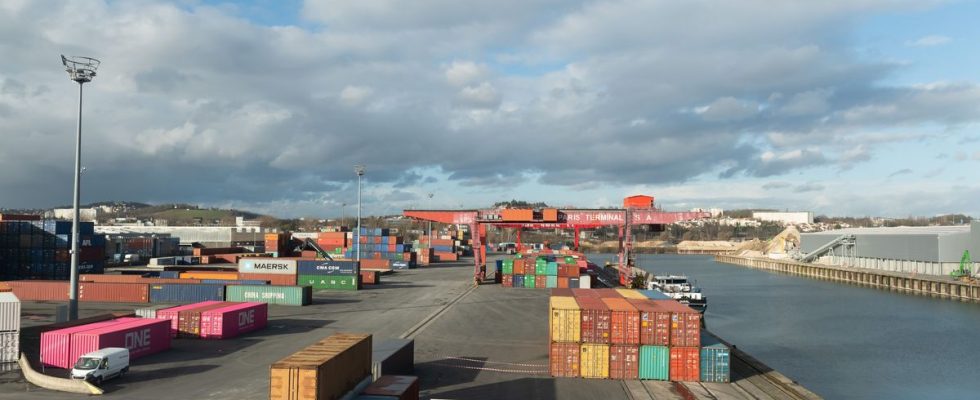This Sunday, a somewhat special picnic takes place in front of the port of Gennevilliers. On the initiative of the Préservation Berges de Seine collective, opponents of the giant warehouse project called Green Dock are coming together to say no to excess. “A gigantism completely above ground, which does not take into account either the urban and natural environment, and which, at the global level, is in total inadequacy with any reasonable industrial development such as it must be done at the time of global warming and threats to biodiversity”, annoys Antoine Gaudin, president of the association Protection Berges de Seine and coordinator of the collective.
But why such anger against this multimodal platform? It is part of the projects of Haropa Port, the major river-sea port on the Seine axis, which extends from Le Havre to Paris, via Rouen, to improve last-mile delivery. “It is a real ecological issue to be able to deliver close to Paris, pleads Patrice Leclerc (PCF), the mayor of Gennevilliers. Thanks to electric vans or by barge, whereas if we build on agricultural land, we will have to deliver by truck to cross the entire Paris region”.
Eco or greenwashing ?
Green Dock is a warehouse project 600 meters long, “i.e. two Stade de France side by side”, specifies Antoine Gaudin, and 35 meters high (the equivalent of a twelve-storey building), 90,000 m2 distributed on four floors, which is to be built on the banks of the Seine, in the port of Gennevilliers. Initially, the building permit was to be filed in January, then in April, in June and finally, Patrice Leclerc speaks of the end of the year. “The platform should open in 2025-2026”, he specifies. The Australian company Goodman, which won the tender, expects a budget of 150 million euros.
“Do we really want this mode of development?, bubbling Antoine Gaudin. Are we still in the 1960s, at the time of industrial gigantism, of unconscious development or have we moved on to the era of a more measured, more conscious development, which would fit more harmoniously into the natural landscape? “. Because if the designers of the project who deliberately baptized it “Green Dock”, affirm that it is ecologically compatible, the opponents denounce a greenwashing barely concealed. “The development of transport by the river is window dressing,” complains the activist.
Like the mayor of Gennevilliers, who notes that “when a barge replaces 40 to 50 trucks, or even 100, it is much more ecological in terms of pollution”, Antoine Gaudin validates the transport of goods by boat. But regrets that for Green Dock specifically, “in the best of cases, only 15% of the goods could transit by the river because the rotation coefficient of the goods by this place would not allow more”. This is also the reason, according to him, for which he speaks of a giga roadside warehouse. “We would not object to a river warehouse at this location, but one that is much lower and smaller to preserve the Natura 2000 area”.
Preserving the Natura 2000 area at all costs
Because the heart of the debate lies in this non-anthropogenic zone, “the first downstream from Paris”. Located opposite the banks where Green Dock is to be built, the Natura 2000 area is located on the tip of Île Saint-Denis, on the other side of the Seine. In particular, it nests there in winter for hundreds of great cormorants and is home to European kingfishers, kestrels and bats. “If the project is successful, these birds, protected by the EU Birds Directive, would have to cohabit with a 35-meter-high glass Great Wall of China, which would cut off their flight paths, which would be lit up all night because this would be a warehouse with an extremely high rotation coefficient, and in an incessant din of heavy goods vehicles,” exclaims the coordinator of the Préservation Berges de Seine collective.
On this aspect, Patrice Leclerc agrees: out of the question for him to annihilate this “natural jewel”. “The major point of attention is not to harm the Natura 2000 area which is opposite. This is the interest of the consultation carried out elsewhere, specifies the city councilor. The promoter, by agreeing to remove the planned greenhouse on the roof, which allows the construction to be lowered by five metres”. “It’s from greenwashing, denounces for his part Antoine Gaudin. The greenhouse on the roof was the culmination of the absurdity of Goodman’s project. Just the opportunity to say “we are going to grow fruits and vegetables in an air saturated with trucks and exhaust gases to make up Green Dock as an ecological project”.
An uncompromising opposition
At the town hall of Gennevilliers, the tone is more measured. “The project leaders still have to work to prevent light and noise from passing to the other side of the Seine, that’s for sure, admits Patrice Leclerc. But using already mineralized areas, such as the port of Gennevilliers, to densify them in economic activities, without touching agricultural land, is in ecological continuity”.
On the other hand, for the representative of the Préservation Berges de Seine collective, Goodman’s inflexibility to negotiate on the dimensions of the building is the main problem. “We are asking for the project to be withdrawn in its current form to take into account this important corridor of biodiversity, and not just repaint the facade in green”. Not glass either, the transparency of the walls also being a major danger for birds. Who in the meantime will be able to peck at the remains of the picnic.

